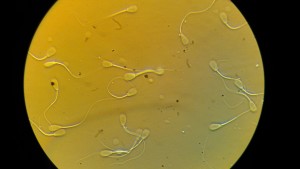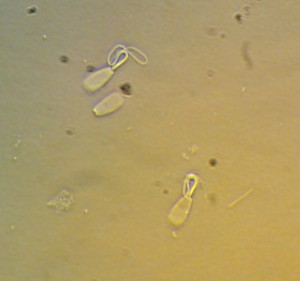Bull Fertility, How Did We Get Here?
Before you read this let’s try a little experiment. What percent of 12 month old bulls will not pass the bull breeding soundness exam? What percent of herd bulls each year will not pass the breeding soundness exam? Write your answer to these two questions and let’s see where we are.
A couple days ago a long time bull producer came in with 6 bulls that he was getting ready for a bull sell. Like many other bull producers he expressed his concerns about having some bulls not pass the breeding soundness exam. A little heat was being placed to insure all of the bulls would pass the exam. I can imagine from his perspective they are all good bulls and the likely hood of any of these bulls not being able to produce a calf is near zero. He has to guarantee that they are fertile any way. From the paradigm he and many producers are used to he is correct. One of the most common phrases I hear from many cow-calf producers is: “I know that bull is good, I have calves out of him.”
After a short discussion about how sperm defects can decrease conception rates I preceded with the exams. The exams and semen collections went uneventful and every bull had good or very good sperm motility. Meaning they are all producing live cells that are ready to swim up to their destination and win the prize. With bulls like that being used this spring we should have calves everywhere next year. Then I came along, kind of like the Grinch that stole Christmas.
Early the next morning I took the air dried samples of semen I had prepared on slides the afternoon before. I set up my phase contrast microscope which allows me to exam sperm cells more easily than a regular light microscope, and got to work to finish the exams. It was time to finish the evaluation by counting 100 or more cells and classifying them according to what we call morphology. Morphology is cell structure, I am looking for weird or abnormally developed cells. Studies show that bulls with more abnormally shaped cells will also have a lower fertility rate.
It takes about 62 days to make one of these little guys and another 11 or so days for them to mature. During that time everything does not always go perfect. Spermatogenisis is the creation of sperm cells and can be influence adversely by too high or low temperatures, too low or high levels of testosterone and other hormones, genetic aberrations, toxins and many other insults. When the cell structure is abnormal it is an indication that other things within the cell are also messed up. Some abnormalities make it so the sperm cell cannot reach the oocyte (egg), sometimes they interfere with fertility in several other ways, and some can still fertilize the egg but the embryo does not develop. We do not understand all of the mechanisms that decrease fertility but we do know that lots of structural abnormalities of any kind even when seen in the cells that never make it to the ova, will decrease fertility rates. The end result is decreased conception rates, or more cycles to settle a cow. Studies indicate that herds culling these sub-fertile bulls have a 6% fertility advantage over herds that do not check their bulls.
The second slide that I examined ended up with too many abnormalities most of which were abnormally shaped heads and “Dag” deformities both of which can be genetic and will decrease fertility. Dag deformities are found in cells that will never make it to the oocyte, yet bulls with over 20% Dag deformities also have lower conception rates.
Over the years perhaps we have become use to a bull ether being fertile or not, the reality is most are somewhere in-between. All too often the pressure to pass bulls in order to make everyone happy has created the situation where almost every bull “passes”. Producers purchase the bulls and keep getting calves, so what is the problem?
I can honestly say that in one way or another I have felt pressure from almost every bull producer that I have tested bulls for. When our producer was told that I had to fail one of his six bulls he hung up on us. Veterinarians need to make their clients happy, if one veterinarian will not pass it perhaps another one will. So we create a happy piece of paper that makes us all feel good and says everything is normal. Over the years we have created a paradigm to make us feel good and a piece of paper to back it up. At least that is my hypothesis. Veterinarians are working for the bull seller not the buyer, the more bulls that pass the better off the bull producers who sell bulls. Turning that around, the more bulls removed for decreased fertility the better off the cow-calf producer who is going to use the bull. Having a high fertility bull means more calves early in the calving season, which equals more money in the cow-calf producer’s pocket. Maybe the wrong person is paying for the exam?
According to some research studies let’s see what percent of bulls will pass the soundness exam. If the bulls are about 12 months of age the average pass rate is around 70% within some breeds as low as 40% and a high of just under 80%. Heard bulls 2 years and older have a pass rate of about 75% which will decrease when the bulls are over 6 years old. I have looked at other studies that show higher rates but the best rates are still around 80% pass rate. These are studies done by well-trained reproductive specialists. When looking at the overall pass rate of the average veterinarian who use the Society for Thereogenology’s electronic forms the pass rate over all is around 87%. But, this is from veterinarians out in the field who are used to higher pass rates, may have very little extra training, and most likely fill a little arm twisting.
Take home message: to achieve early calves and improve profits check all your bulls yearly and check every bull you buy before you turn it out with cows. Do not accept the fact that the bull seller says they have all been fertility checked or fertility guaranteed, know what that really means. The most important trait of any cattle herd is high reproductive efficiency, so buy bulls to positively support this. The closer to breeding time that you check the bulls the more accurate the prognosis for achieving a highly reproductively efficient herd. Choosing a veterinarian who really understands morphology and its significance along with  good quality equipment to detect these abnormalities is also needed. To remove conflicts of interest it may be best if prepared semen slides are sent in to a central lab and evaluated by a trained 3rd party individual who will not have any biases. This will take the heat off from the veterinarian and he/she can keep better relationships with the producers they serve.
good quality equipment to detect these abnormalities is also needed. To remove conflicts of interest it may be best if prepared semen slides are sent in to a central lab and evaluated by a trained 3rd party individual who will not have any biases. This will take the heat off from the veterinarian and he/she can keep better relationships with the producers they serve.




